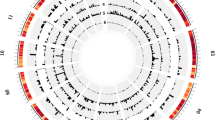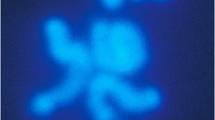Abstract
The evolution of nine microsatellites and one minisatellite was investigated in the fungus Fusarium oxysporum and sister taxa Fusarium redolens and Fusarium verticillioides. Compared to other organisms, fungi have been reported to contain fewer and less polymorphic microsatellites. Mutational patterns over evolutionary time were studied for these ten loci by mapping changes in core repeat numbers onto a phylogeny based on the sequence of the conserved translation elongation factor 1-α gene. The patterns of microsatellite formation, expansion, and interruption by base substitutions were followed across the phylogeny, showing that these loci are evolving in a manner similar to that of microsatellites in other eukaryotes. Most mutations could be fit to a stepwise mutation model, but a few appear to have involved multiple repeat units. No evidence of gene conversion was seen at the minisatellite locus, which may also be mutating by replication slippage. Some homoplastic numbers of repeat units were observed for these loci, and polymorphisms in the regions flanking the microsatellites may provide better genetic markers for population genetics studies of these species.





Similar content being viewed by others
References
Ananda G, Hile SE, Breski A, Wang Y, Kelkar Y, Makova KD, Eckert KA (2014) Microsatellite interruptions stabilize primate genomes and exist as population-specific single nucleotide polymorphisms within individual human genomes. PLoS Genet 10:e1004498
Baayen RP, O’Donnell K, Breeuwsma S, Geiser DM, Waalwijk C (2001) Molecular relationships of fungi within the Fusarium redolens-F. hostae clade. Phytopathology 91:1037–1044
Bally P, Grandaubert J, Rouxel T, Balesdent MH (2010) FONZIE: an optimized pipeline for minisatellite marker discovery and primer design from large sequence data sets. BMC Res Notes 3:322
Barthe S, Gugerli F, Barkley NA, Maggia L, Cardi C, Scotti I (2012) Always look on both sides: phylogenetic information conveyed by simple sequence repeat allele sequences. PLoS One 7:e40699
Brandström M, Ellegren H (2008) Genome-wide analysis of microsatellite polymorphism in chicken circumventing the ascertainment bias. Genome Res 18:881–887
Brohede J, Ellegren H (1999) Microsatellite evolution: polarity of substitutions within repeats and neutrality of flanking sequences. Proc R Soc Lond B 266:825–833
Buschiazzo E, Gemmell NJ (2006) The rise, fall and renaissance of microsatellites in eukaryotic genomes. BioEssays 28:1040–1050
Chambers GK, MacAvoy ES (2000) Microsatellites: consensus and controversy. Compar Biochem Physiol B 126:455–476
Darling ACE, Mau B, Blattner FR, Perna NT (2004) Mauve: multiple alignment of conserved genomic sequence with rearrangements. Genome Res 14:1394–1403
Demers JE, Garzón CD, Jiménez-Gasco MM (2014) Striking genetic similarity between races of Fusarium oxysporum f. sp. ciceris confirms a monophyletic origin and clonal evolution of the chickpea vascular wilt pathogen. Eur J Plant Path 139:303–318
Dettman JR, Taylor JW (2004) Mutation and evolution of microsatellite loci in Neurospora. Genetics 168:1231–1248
Dieringer D, Schlötterer C (2003) Two distinct modes of microsatellite mutation processes: evidence from the complete genomic sequences of nine species. Genome Res 13:2242–2251
Dutech C, Enjalbert J, Fournier E, Delmotte F, Barrès B, Carlier J, Tharreau D, Girand T (2007) Challenges of microsatellite isolation in fungi. Fungal Genet Biol 44:933–949
Fusarium Comparative Database (2012) Broad Institute. Available from http://www.broadinstitute.org/annotation/genome/fusarium_graminearum/MultiHome.html. Accessed Jan 2012
Giraud T, Fortini D, Levis C, Brygoo Y (1998) The minisatellite MSB1, in the fungus Botrytis cinerea, probably mutates by slippage. Mol Biol Evol 15:1524–1531
Harr B, Zangerl B, Schlötterer C (2000) Removal of microsatellite interruptions by DNA replication slippage: phylogenetic evidence from Drosophila. Mol Biol Evol 17:1001–1009
Henderson ST, Petes TD (1992) Instability of simple sequence DNA in Saccharomyces cerevisiae. Mol Cell Biol 12:2749–2757
Hey J, Wakeley J (1997) A coalescent estimator of the population recombination rate. Genetics 145:833–846
Hua-Van A, Davière JM, Kaper F, Langin T, Daboussi MJ (2000) Genome organization in Fusarium oxysporum: clusters of class II transposons. Curr Genet 37:339–347
International Human Genome Sequencing Consortium (2001) Initial sequencing and analysis of the human genome. Nature 409:860–921
Karaoglu H, Lee CMY, Meyer W (2005) Survey of simple sequence repeats in completed fungal genomes. Mol Biol Evol 22:639–649
Katti MV, Ranjekar PK, Gupta VS (2001) Differential distribution of simple sequence repeats in eukaryotic genome sequences. Mol Biol Evol 18:1161–1167
Kayser M, Roewer L, Hedman M et al (2000) Characteristics and frequency of germline mutations at microsatellite loci from the human Y chromosome, as revealed by direct observation in father/son pairs. Am J Human Genet 66:1580–1588
Kelkar YD, Tyekucheva S, Chiaromonte F, Makova KD (2008) The genome-wide determinants of human and chimpanzee microsatellite evolution. Genome Res 18:30–38
Kelkar YD, Strubczewski N, Hile SE, Chiaromonte F, Eckert KA, Makova KD (2010) What is a microsatellite: a computational and experimental definition based on repeat mutational behavior at A/T and GT/AC repeats. Genome Biol Evol 2:620–635
Kelkar YD, Eckert KA, Chiaromonte F, Makova KD (2011) A matter of life or death: how microsatellites emerge in and vanish from the human genome. Genome Res 21:2038–2048
Kofler R, Schlötterer C, Luschützky E, Lelley T (2008) Survey of microsatellite clustering in eight fully sequenced species sheds light on the origin of compound microsatellites. BMC Genom 9:612
Labbé J, Murat C, Morin E, Le Tacon F, Martin F (2011) Survey and analysis of simple sequence repeats in the Laccaria bicolor genome, with development of microsatellite markers. Curr Genet 57:75–88
Levinson G, Gutman GA (1987) Slipped-strand mispairing: a major mechanism for DNA sequence evolution. Mol Biol Evol 4:203–221
Liu M, Rodrigue N, Kolmer J (2014) Population divergence in the wheat leaf rust fungus Puccinia triticina is correlated with wheat evolution. Heredity 112:443–453
Ma L-J, van der Does HC, Borkovich KA et al (2010) Comparative genomics reveals mobile pathogenicity chromosomes in Fusarium. Nature 464:367–373
Nei M (1987) Molecular evolutionary genetics. Columbia University Press, New York
Nielsen R (1997) A maximum likelihood approach to population samples of microsatellite alleles. Genetics 146:711–716
O’Donnell K, Kistler HC, Cigelnik E, Ploetz RC (1998) Multiple evolutionary origins of the fungus causing Panama disease of banana: concordant evidence from nuclear and mitochondrial gene genealogies. Proc Natl Acad Sci USA 95:2044–2049
Paun O, Hörandl E (2006) Evolution of hypervariable microsatellites in apomictic polyploid lineages of Ranunculus carpaticola: directional bias at dinucleotide loci. Genetics 174:387–398
Payseur BA, Jing P (2009) A genomewide comparison of population structure at STRPs and nearby SNPs in humans. Mol Biol Evol 26:1369–1377
Putman AI, Carbone I (2014) Challenges in analysis and interpretation of microsatellite data for population genetic studies. Ecol Evol 4:4399–4428
Richard G-F, Dujon B (2006) Molecular evolution of minisatellites in hemiascomycetous yeasts. Mol Biol Evol 23:189–202
Richard G-F, Kerrest A, Dujon B (2008) Comparative genomics and molecular dynamics of DNA repeats in eukaryotes. Microbiol Mol Biol Rev 72:686–727
Ronquist F, Huelsenbeck JP (2003) MrBayes 3: bayesian phylogenetic inference under mixed models. Bioinformatics 19:1572–1574
Santibáñez-Koref MF, Gangeswaran R, Hancock JM (2001) A relationship between lengths of microsatellites and nearby substitution rates in mammalian genomes. Mol Biol Evol 18:2119–2123
Sawaya SM, Lennon D, Buschiazzo E, Gemmell N, Minin VN (2012) Measuring microsatellite conservation in mammalian evolution with a phylogenetic birth–death model. Genome Biol Evol 4:748–759
Schoebel CN, Brodbeck S, Buehler D, Cornejo C, Gajurel J, Hartikainen H, Keller D, Leys M, Říčanová Š, Segelbacher G, Werth S, Csencsics D (2013) Lessons learned from microsatellite development for nonmodel organisms using 454 pyrosequencing. J Evol Biol 26:600–611
Skovgaard K, Rosendahl S, O’Donnell K, Nirenberg HI (2003) Fusarium commune is a new species identified by morphological and molecular phylogenetic data. Mycologia 95:630–636
Sun JX, Helgason A, Masson G, Ebenesersdóttir SS, Li H, Mallick S, Gnerre S, Patterson N, Kong A, Reich D, Stefansson K (2012) A direct characterization of human mutation based on microsatellites. Nat Genet 44:1161–1165
Taylor JW, Fisher MC (2003) Fungal multilocus sequence typing—it’s not just for bacteria. Curr Opin Microbiol 6:351–356
Tóth G, Gáspári Z, Jurka J (2000) Microsatellites in different eukaryotic genomes: survey and analysis. Genome Res 10:967–981
Weetman D, Hauser L, Carvalho GR (2006) Heterogeneous evolution of microsatellites revealed by reconstruction of recent mutation history in an invasive apomictic snail, Potamopyrgus antipodarum. Genetica 127:285–293
Yun S-H, Arie T, Kaneko I, Yoder OC, Turgeon BG (2000) Molecular organization of mating type loci in heterothallic, homothallic, and asexual Gibberella/Fusarium species. Fungal Genet Biol 31:7–20
Zhu Y, Queller DC, Strassmann JE (2000a) A phylogenetic perspective on sequence evolution in microsatellite loci. J Mol Evol 50:324–338
Zhu Y, Strassmann JE, Queller DC (2000b) Insertions, substitutions, and the origin of microsatellites. Genet Res 76:227–236
Acknowledgments
This work was part of the dissertation of J. E. D., which was funded by the Pennsylvania State University Graduate Fellowship program and a Microbial Functional Genomics Training Fellowship funded to Dr. Seogchan Kang.
Author information
Authors and Affiliations
Corresponding author
Electronic supplementary material
Below is the link to the electronic supplementary material.
Rights and permissions
About this article
Cite this article
Demers, J.E., Jiménez-Gasco, M. Evolution of Nine Microsatellite Loci in the Fungus Fusarium oxysporum . J Mol Evol 82, 27–37 (2016). https://doi.org/10.1007/s00239-015-9725-5
Received:
Accepted:
Published:
Issue Date:
DOI: https://doi.org/10.1007/s00239-015-9725-5




